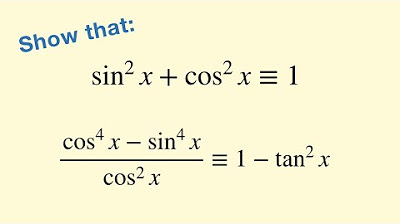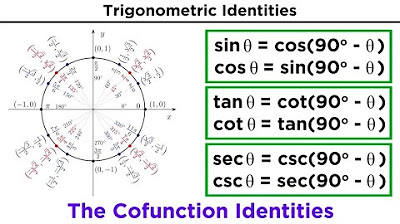Pythagorean Identities - Examples & Practice Problems, Trigonometry
TLDRThe video script delves into the Pythagorean identities, focusing on their applications in trigonometry. It explains three key identities: sine squared plus cosine squared equals one, one plus tangent squared equals secant squared, and one plus cotangent squared equals cosecant squared. The script provides step-by-step examples to demonstrate how to find the value of cosine or sine when one is given, using the first identity. It also discusses the importance of considering the quadrant in which the angle lies to determine the correct sign for the trigonometric function. The examples cover scenarios where sine or cosine values are known, and the script guides viewers on how to calculate the missing trigonometric value while considering the angle's quadrant.
Takeaways
- 📚 The script discusses three Pythagorean identities: sine squared plus cosine squared equals one, one plus tangent squared equals secant squared, and one plus cotangent squared equals cosecant squared.
- 🔍 The first identity, sine squared theta plus cosine squared theta equals one, is the primary focus and is used to find the value of cosine when sine is known.
- 📉 Given sine theta equals 4/5 and angle theta is between 0 and 90 degrees, the script demonstrates how to calculate cosine theta as positive 3/5 using the Pythagorean identity.
- 📐 The script explains that the value of cosine is found by subtracting sine squared from one and then taking the square root of the result.
- 📈 The sign of the cosine value is determined by the quadrant in which the angle theta lies; in quadrant one, cosine is positive.
- 🔄 Another example is given where cosine theta equals 8/17 and angle theta is between 3π/2 and 2π, indicating that the angle is in quadrant four where sine is negative and cosine is positive.
- 📝 The script shows the calculation of sine theta when given cosine theta equals 8/17, resulting in sine theta being negative 15/17.
- 🔢 A third example is presented where sine theta equals 2/5 and tangent theta is less than zero, indicating the angle is in quadrant four where both sine and cosine are positive.
- 📌 The script uses the Pythagorean identity to find cosine theta as positive square root of 21 over 5 when sine theta is 2/5 and tangent theta is negative.
- 📘 The importance of understanding the quadrant in which the angle lies is emphasized to determine the correct sign of the trigonometric values.
- 📚 The script concludes by reinforcing the use of the Pythagorean identity to find the missing trigonometric function value based on the known function and angle quadrant.
Q & A
What are the three Pythagorean identities mentioned in the script?
-The three Pythagorean identities mentioned are: 1) sine squared theta plus cosine squared theta equals one, 2) one plus tangent squared equals secant squared, and 3) one plus cotangent squared equals cosecant squared.
If sine theta equals 4/5 and theta is between 0 and 90 degrees, how do you find the value of cosine theta?
-Using the Pythagorean identity sine squared plus cosine squared equals one, and knowing sine theta is 4/5, you square both sides (16/25) and subtract from 1 (25/25) to get cosine squared theta equals 9/25. Taking the square root gives cosine theta as ±3/5. Since theta is in quadrant one (0 to 90 degrees), where cosine is positive, the value is +3/5.
What is the significance of the quadrant in determining the sign of the trigonometric functions?
-The quadrant in which the angle theta lies determines the signs of the trigonometric functions. For example, in quadrant one, both sine and cosine are positive, while in quadrant four, sine is negative and cosine is positive.
How does the script use the Pythagorean identity to find the value of sine theta when cosine theta is given as 8/17 and theta is between 3π/2 and 2π?
-The script uses the identity sine squared plus cosine squared equals one to find sine. With cosine theta as 8/17, squaring both sides gives 64/289. Subtracting this from 1 (289/289) gives sine squared theta as 225/289. Taking the square root gives sine theta as ±15/17. Since theta is in quadrant four (between 270 and 360 degrees), where sine is negative, the value is -15/17.
What is the relationship between tangent and the quadrants in the script's third example?
-In the third example, the script explains that tangent is less than zero in quadrants two and four. Since sine is positive and tangent is negative, the angle must be in quadrant four where cosine is positive.
How does the script determine the value of cosine theta when sine theta is 2/5 and tangent theta is less than zero?
-Using the identity sine squared plus cosine squared equals one, and knowing sine theta is 2/5, the script calculates cosine squared theta as 21/25. Taking the square root gives cosine theta as ±√21/5. Since the angle is in quadrant four where cosine is positive, the value is +√21/5.
Why is it necessary to consider the quadrant when finding the trigonometric function values?
-Considering the quadrant is necessary because it determines the signs of the trigonometric functions. Without knowing the quadrant, you cannot determine whether the functions should be positive or negative.
What is the formula used to find the value of cosine when sine is given?
-The formula used to find the value of cosine when sine is given is cosine squared theta equals one minus sine squared theta, derived from the Pythagorean identity sine squared plus cosine squared equals one.
How does the script handle the square root of a fraction in the process of finding cosine or sine values?
-The script separates the square root of the numerator and the square root of the denominator when handling the square root of a fraction, as seen when finding cosine theta with sine theta as 2/5.
Can the script's method be used to find the value of tangent or cotangent using the Pythagorean identities?
-While the script focuses on sine and cosine, the method of using Pythagorean identities can be adapted to find tangent or cotangent values by using the identities one plus tangent squared equals secant squared and one plus cotangent squared equals cosecant squared.
What is the significance of the angle theta being between 0 and 90 degrees in the first example?
-The significance is that it places theta in quadrant one, where both sine and cosine are positive. This information is crucial for determining the correct sign of the cosine value.
Outlines
📚 Pythagorean Identities and Solving for Cosine Theta
This paragraph introduces three Pythagorean identities essential for trigonometry: sine squared plus cosine squared equals one, one plus tangent squared equals secant squared, and one plus cotangent squared equals cosecant squared. The focus is on the first identity and its application to find the value of cosine theta when sine theta is given. An example is provided where sine theta equals 4/5 and angle theta is between 0 and 90 degrees. Using the identity, the calculation leads to cosine theta being positive 3/5, considering the angle's location in the first quadrant where cosine is positive.
🔍 Determining Sine Theta and Cosine Theta Using Quadrants
The second paragraph explores the use of trigonometric identities to determine the values of sine and cosine for given angles, with a focus on understanding which quadrant the angle lies in to choose the correct sign for the values. Two examples are given: one where cosine theta is 8/17 and the angle is between 3π/2 and 2π, indicating quadrant 4 where sine is negative, leading to sine theta being -15/17. The other example involves sine theta being 2/5 with tangent theta less than zero, which places the angle in quadrant 4. The calculation for cosine theta results in a positive value of √21/5, as cosine is positive in quadrant 4.
Mindmap
Keywords
💡Pythagorean Identities
💡sine squared
💡cosine squared
💡tangent squared
💡secant squared
💡cotangent squared
💡Quadrant
💡Square root
💡Trigonometric functions
💡Radians
💡Degrees
Highlights
Introduction to the Pythagorean identities in trigonometry.
Three main Pythagorean identities are sine squared plus cosine squared equals one, one plus tangent squared equals secant squared, and one plus cotangent squared equals cosecant squared.
Using the first Pythagorean identity to find the value of cosine when sine is given.
Example calculation where sine theta equals 4/5 and angle theta is between 0 and 90 degrees.
Demonstration of finding cosine theta using the identity sine squared plus cosine squared equals one.
Determining the sign of cosine based on the quadrant in which the angle lies.
Another example where cosine theta equals 8/17 and angle theta is between 3pi/2 and 2pi.
Using the Pythagorean identity to find sine theta when cosine theta is given.
Determining the sign of sine based on the quadrant of the angle.
Example with sine theta equals 2/5 and tangent theta is less than zero.
Identifying the quadrant of the angle based on the signs of sine and tangent.
Finding the value of cosine theta when sine theta is given and the angle is in a specific quadrant.
Explanation of the process to find cosine theta using the Pythagorean identity and choosing the correct sign based on the quadrant.
Final answer for cosine theta when the angle is in quadrant four and sine is positive but tangent is negative.
Emphasis on the importance of the quadrant in determining the signs of trigonometric functions.
Transcripts
Browse More Related Video

Verifying Trigonometric Identities Using Half Angle Formulas

Verifying Trigonometric Identities

Identities Grade 11: Introduction and practice

Intro to Trigonometric Identities - part 1

Basic Trigonometric Identities: Pythagorean Identities and Cofunction Identities

How to Convert From Polar Equations to Rectangular Equations (Precalculus - Trigonometry 40)
5.0 / 5 (0 votes)
Thanks for rating: